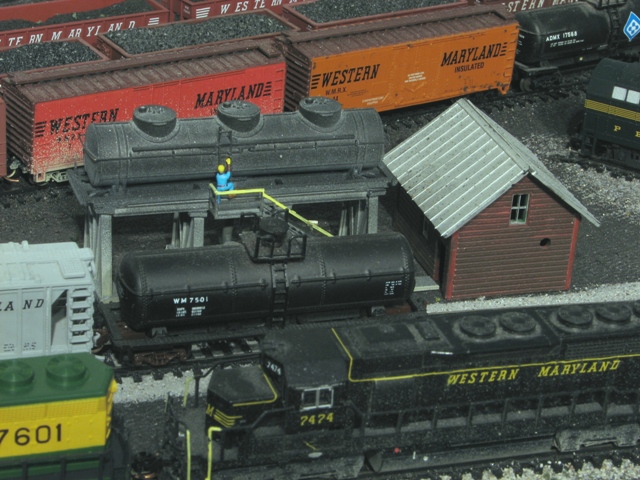I’m currently in the process of building my n scale layout set in the 1940’s. All of my steam engines are coal fired so I have no problem figuring out how to service them…Problem is, my Challenger is OIL fired. So my question is, how would I model a servicing area for an oil fired locomotive, and feel free to give any ideas toward the layout.
There would be a stand-pipe adjacent to the track where the locomotive refueled. There are models commercially available. An undergound pipe would lead to a not-too-distant under-ground or above-ground storage tank and a pump house. Small facilities (wouldn’t be suitable for fueling a Challenger) might have a pipe coming directly using gravity from an elevated tank adjacent to the track. Locomotive fuel oil was viscous, so there should be a small steam plant nearby to warm the fuel so it will flow.
Mark
Which Challenger was oil fired in the 1940s? I thought all of them were built as coal burners, and 3985 was only modified long after regular steam operation had ended.
Also, a railroad which only ran coalburners would be unlikily to roster a single oil burner. PRR didn’t get into that predicament until they leased locos from the Santa Fe, at a time when, ‘The Standard Railroad of the World,’ was beginning to hemmhorage red ink - and they leased a lot more than one.
Final analysis? Either get more oil burners and model the engine change point that marked the break between, or modify your Challenger’s tender to carry coal.
(I personally model an engine change point where coal yielded to catenary. The oil burners are DMU and diesel-hydraulics, and refuel somewhere in staging.)
Chuck (Modeling Central Japan in September, 1964)
Per Wikipedia:
“UP 3985 operated in its last “regular” train service in 1957.[1] The locomotive was retired about 1962 and after many years of storage in a roundhouse at Cheyenne, Wyoming. UP 3985 was placed on outdoor display beside the Cheyenne depot in 1975. Beginning in 1979 a group of Union Pacific employee-volunteers started work on overhauling the locomotive, and it was returned to operational condition in 1981.[1] Originally a coal-burner, to prevent lineside grass fires it was successfully converted to oil firing in 1990.”
Yup, to backdate the locomotive when the UP operated coal-fired locomotives, the owner needs to get a coal tender if he desires to be prototypical.
Mark
The Union Pacific modified 15 of the late Challengers to burn oil in 1946 and renumbered them into the 3700 class. I am not sure if you have an oil fired 3985, but it was always coal fired until 1990’s as stated. The Union Pacific also had the early Challengers that were converted to be oil fired in the 46 era and renumbered into the 3800 series.
To be true to the prototype, you could renumber the oil fired locomotive, but if it is the Genesis N scale, it has the Oil containment boxes on top of the oil compartment and it is not correct for any in service era UP steam locomotive.
In that case, you can use Modeler’s license and just run it.
CZ
Thanks for all the info guys, but I don’t have 3985…I’m modelling Union Pacific in the mountains (very loose for prototypically accurate stuff, its my first layout), and my Challenger is 3977, which is Athearn(probably should have mentioned that…sorry). The only reason it’d be on my layout is to to shuttle the UP streamliner I have around.
In the 1930’s, a lot of eastern cities passed “smoke” ordinances that prohibited or severely limited the operation of coal fired steam locomotives in the city proper. In Baltimore, this led to the electrification of the B&O’s Baltimore Belt Line, and the conversion of the WM’s passenger engines to oil. Since the passenger engines only operated out of Hillen Station, close to downtown, I think the freight operations down at the harbor were exempt.
I rebuilt an old Atlas/Rivarossi Pacific to look more or less like a WM K-2 converted to oil.

I’ve never seen any photos of the oil facilities up close, but at Union Bridge, mid point of the Baltimore-Hagerstown runs, and terminus of the daily commuter trains to Baltimore, there were two large tanks up on an elevated rack. The photos I’ve seen look like old tank cars, including the domes. To keep the oil flowing into 204’s bunker, I took some bridge parts and an old Bachman tank car and built this:

I added some Plastruct stair parts and railings, and used a brake wheel and some piping to make some valves and what not underneath.
Hope this is useful.
Lee
Thanks, these photos really help me get the idea. My Challenger is just a tad bigger than engine 204, so I don’t think a tank car will cut it [:D]
You have the perfect model for an oil fired engine. The 3977 was converted in to oil for passenger service in 46 or so and renumbered 3710 later on. It was renumbered back to 3977 when it was donated and is Cody park in North Platte Neb.
CZ
A few years ago, it was repainted back into the passenger colors, two tone gray.
Oh, ok…well it seems I’m set then…now to get my hands on one of those industrial sized coaling towers for the rest of my power…Thanks guys